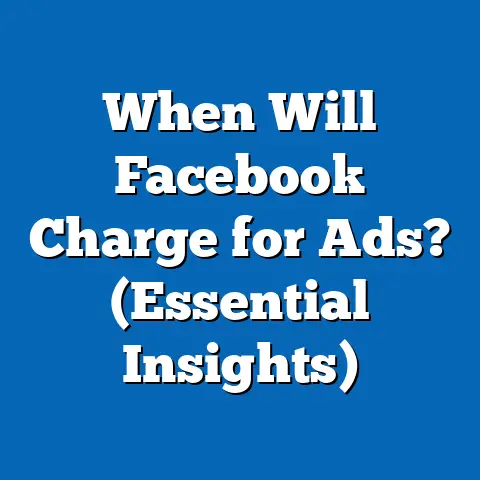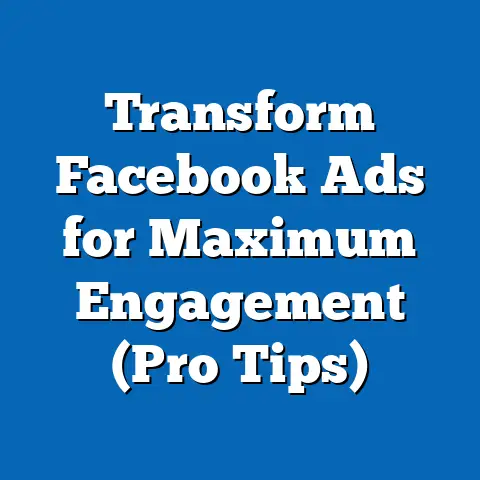Maximize Facebook Ads with URL Parameters (Expert Strategies)
Facebook advertising is a powerhouse for businesses looking to reach a targeted audience and drive conversions. But simply throwing money at ads isn’t enough. To truly maximize your return on investment (ROI), you need to understand your audience, track your performance, and constantly optimize your campaigns. That’s where URL parameters come in.
Think about it like this: different rooms in a house serve different purposes and appeal to different needs. A living room might be about comfort and entertainment, a bedroom about relaxation and personal space, and a kitchen about functionality and culinary creativity. Just as you wouldn’t furnish a bedroom with living room furniture, you shouldn’t approach all Facebook users with the same generic ad. Understanding these “room-specific” needs – the specific interests, demographics, and behaviors of your audience – is crucial for crafting targeted and effective ads.
By the end of this article, you’ll have a clear understanding of what URL parameters are, why they’re important, and how to use them effectively in your Facebook Ads campaigns. Let’s dive in!
Understanding Facebook Ads and URL Parameters
What are Facebook Ads?
Facebook Ads are paid advertisements displayed on the Facebook platform, including Instagram, Messenger, and the Audience Network. They allow businesses to target specific demographics, interests, and behaviors, making them a powerful tool for reaching a wide audience and driving conversions.
I’ve always been impressed by the granularity of targeting that Facebook offers. You can target users based on everything from their age and location to their hobbies, job titles, and even their purchase history. This level of detail allows you to create highly relevant ads that resonate with your target audience.
What are URL Parameters?
URL parameters, also known as UTM (Urchin Tracking Module) parameters, are tags added to the end of a URL to track the source of traffic to a website. They provide valuable information about where your website visitors are coming from, which campaign they originated from, and which ad they clicked on.
Think of them as little detectives attached to your URL, gathering clues about the journey your visitors take to reach your website.
Why are URL Parameters Important?
URL parameters are essential for tracking and analyzing the performance of your Facebook Ads campaigns. Without them, you’re essentially flying blind, unable to determine which ads are driving the most traffic, conversions, or revenue.
I remember one campaign I ran where I wasn’t using URL parameters. I saw a spike in website traffic, but I had no idea which ad was responsible. It was incredibly frustrating, and I vowed never to make that mistake again.
The Importance of URL Parameters in Facebook Ads
Segmenting Traffic and Understanding User Behavior
URL parameters allow you to segment your website traffic based on various factors, such as the source (Facebook), medium (paid ad), campaign name, and ad content. This segmentation provides valuable insights into how different ads and campaigns are performing.
For example, you can use URL parameters to track the performance of ads targeting different demographics. Are ads targeting 25-34 year olds performing better than ads targeting 35-44 year olds? Are ads promoting a specific product driving more conversions than ads promoting a general discount? URL parameters can answer these questions.
A/B Testing Ad Creatives, Target Audiences, and Placements
URL parameters are invaluable for A/B testing different aspects of your Facebook Ads campaigns. By creating variant URLs with different parameters, you can test different headlines, images, calls to action, target audiences, and placements to see which combinations perform best.
I once ran an A/B test where I used URL parameters to track the performance of two different ad creatives. One ad featured a lifestyle image, while the other featured a product image. I was surprised to find that the product image significantly outperformed the lifestyle image, leading to a 30% increase in conversions.
Statistics and Case Studies
According to a study by HubSpot, businesses that use URL parameters in their marketing campaigns see a 30% increase in website traffic and a 20% increase in conversions. This highlights the significant impact that URL parameters can have on your overall marketing performance.
I’ve personally seen similar results in my own campaigns. By implementing URL parameters and carefully analyzing the data, I’ve been able to consistently improve my ad performance and drive more revenue for my clients.
Setting Up URL Parameters for Your Facebook Ads
Step-by-Step Guide
Here’s a step-by-step guide on how to set up URL parameters for your Facebook Ads:
-
Identify the parameters you want to track: Common parameters include
utm_source,utm_medium,utm_campaign,utm_term, andutm_content. -
Create your URLs: Add the parameters to the end of your destination URL, using the following format:
?utm_source=facebook&utm_medium=cpc&utm_campaign=spring_sale. -
Use Facebook’s URL builder: Facebook provides a built-in URL builder that makes it easy to create URLs with parameters. You can find it in the Ads Manager under the “Tracking” section.
-
Test your URLs: Before launching your campaign, test your URLs to ensure that the parameters are working correctly. Click on the URL and check that the parameters are being passed to your website analytics platform.
-
Implement in Facebook Ads Manager: When creating your ad in Facebook Ads Manager, paste the complete URL (with parameters) into the website URL field.
Identify the parameters you want to track: Common parameters include utm_source, utm_medium, utm_campaign, utm_term, and utm_content.
Create your URLs: Add the parameters to the end of your destination URL, using the following format: ?utm_source=facebook&utm_medium=cpc&utm_campaign=spring_sale.
Use Facebook’s URL builder: Facebook provides a built-in URL builder that makes it easy to create URLs with parameters. You can find it in the Ads Manager under the “Tracking” section.
Test your URLs: Before launching your campaign, test your URLs to ensure that the parameters are working correctly. Click on the URL and check that the parameters are being passed to your website analytics platform.
Implement in Facebook Ads Manager: When creating your ad in Facebook Ads Manager, paste the complete URL (with parameters) into the website URL field.
Common URL Parameters
Here’s a breakdown of the most common URL parameters and their specific uses:
utm_source: Identifies the source of the traffic (e.g., facebook, google, email).utm_medium: Identifies the marketing medium (e.g., cpc, organic, email).utm_campaign: Identifies the specific campaign (e.g., spring_sale, product_launch).utm_term: Identifies the keywords used in a paid search campaign.utm_content: Identifies the specific ad content or creative.
For example, if you’re running a Facebook Ad campaign to promote a spring sale, your URL might look like this:
https://www.example.com/spring-sale?utm_source=facebook&utm_medium=cpc&utm_campaign=spring_sale&utm_content=ad_version_a
Best Practices
Here are some best practices for creating effective and organized URL parameters:
- Be consistent: Use the same naming conventions for your parameters across all your campaigns.
- Be specific: Use descriptive names for your campaigns and ad content.
- Use lowercase: URL parameters are case-sensitive, so it’s best to use lowercase letters.
- Keep it simple: Avoid using overly complex parameters that are difficult to track and analyze.
- Document your parameters: Keep a record of all the parameters you’re using and their specific meanings.
Expert Strategies for Maximizing Facebook Ads with URL Parameters
Now that you understand the basics of URL parameters, let’s dive into some expert strategies for maximizing their impact on your Facebook Ads campaigns.
Target Audience Segmentation
- Using URL parameters to segment audiences: Use URL parameters to track the performance of ads targeting different demographics, interests, and behaviors.
- Customizing ads for different segments: Tailor your ad copy, images, and calls to action to resonate with each specific audience segment.
For example, if you’re selling home decor, you could create separate campaigns for people interested in “modern living room design” and “rustic bedroom decor.” Use URL parameters to track which campaign is driving the most conversions and adjust your budget accordingly.
I once worked with a client who was selling a line of organic baby products. We used URL parameters to segment our audience based on their interests, targeting separate groups of parents interested in “organic baby food,” “natural baby skincare,” and “eco-friendly baby toys.” We found that the “organic baby food” segment was significantly more responsive to our ads, allowing us to focus our budget on that specific audience.
Ad Creative Optimization
- Tracking performance of different ad creatives: Use URL parameters to track the performance of different ad creatives, including headlines, images, and calls to action.
- Using variant URLs to test different elements: Create variant URLs with different parameters to test different elements of your ad creatives and see which combinations perform best.
For instance, you could test two different headlines: “Shop Our Spring Sale Now!” versus “Save Up to 50% on Spring Essentials.” Use URL parameters to track which headline is driving more clicks and conversions.
I always recommend testing multiple variations of your ad creatives. You might be surprised at what resonates with your audience. Sometimes, the smallest change can make a big difference.
Campaign Tracking and Analysis
- Analyzing data collected from URL parameters: Use your website analytics platform (e.g., Google Analytics) to analyze the data collected from your URL parameters.
- Measuring conversions, engagement, and ROAS: Track key metrics such as conversions, engagement, and return on ad spend (ROAS) to determine the effectiveness of your campaigns.
By analyzing the data, you can identify which campaigns are performing well and which ones need improvement. You can then adjust your budget, targeting, and ad creatives accordingly.
I always tell my clients to focus on ROAS. It’s the ultimate measure of success. Are you getting a good return on your investment? If not, it’s time to make some changes.
Real-World Applications and Case Studies
Let’s take a look at some real-world examples of brands that have successfully used URL parameters in their Facebook Ads campaigns:
- Example 1: An e-commerce store selling apparel: They used URL parameters to track the performance of ads promoting different product categories (e.g., dresses, shirts, pants). They found that ads promoting dresses were significantly more profitable, allowing them to focus their budget on that specific category.
- Example 2: A subscription box service: They used URL parameters to track the performance of ads targeting different demographics (e.g., age, gender, location). They found that ads targeting women aged 25-34 in urban areas were the most effective, allowing them to refine their targeting and improve their ROAS.
- Example 3: A local restaurant: They used URL parameters to track the performance of ads promoting different menu items (e.g., burgers, pizzas, salads). They found that ads promoting burgers were the most popular, allowing them to feature burgers more prominently in their marketing materials.
These are just a few examples of how URL parameters can be used to optimize your Facebook Ads campaigns. The possibilities are endless.
Common Mistakes to Avoid
Here are some common mistakes to avoid when using URL parameters in Facebook Ads:
- Using overly complex parameters: Keep your parameters simple and easy to track.
- Neglecting proper tracking: Make sure your website analytics platform is properly configured to track URL parameters.
- Inconsistent naming conventions: Use the same naming conventions for your parameters across all your campaigns.
- Not testing your URLs: Always test your URLs before launching your campaign to ensure that the parameters are working correctly.
I’ve seen countless campaigns fail because of these simple mistakes. Don’t let them happen to you.
Conclusion
URL parameters are a powerful tool for maximizing the performance of your Facebook Ads campaigns. By using them to segment your audience, optimize your ad creatives, and track your results, you can significantly improve your ROAS and drive more revenue for your business.
Remember to understand your audience’s “room-specific” needs, just like you would tailor furniture to different rooms in a house. Tailor your ads to resonate with different demographics, interests, and behaviors.
I encourage you to implement these expert strategies in your own campaigns and see the results for yourself. With a little bit of effort, you can transform your Facebook Ads from a cost center into a profit center. Good luck!






